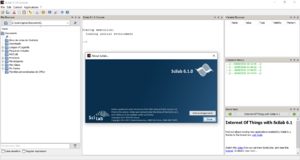Scilab facts for kids
 |
|

Screenshot of Scilab 6.1
|
|
| Developer(s) | Dassault Systèmes |
|---|---|
| Stable release | |
| Written in | Scilab, C, C++, Java, Fortran |
| Operating system | BSDs (e.g., FreeBSD), Linux, macOS, Windows |
| Available in | English, German, Spanish, French, Italian, Japanese, Portuguese (Brazil), Russian, Ukrainian, Chinese, Czech, Polish |
| Type | Technical computing |
| License | GPLv2, previously CeCILL |
Scilab is a special computer program and a programming language. It helps people do complex math and science calculations. It's like a powerful calculator that can also run special instructions.
Scilab is free to use and change, which means anyone can download and use it without paying. It works on many different computers, like Windows, Mac, and Linux. People use Scilab for things like understanding signals, looking at data, making pictures clearer, and even simulating how liquids move. It can also help solve math problems and create models of systems that change over time.
Scilab is one of the main free alternatives to another popular program called MATLAB. While Scilab is not exactly the same as MATLAB, it is similar enough that if you learn one, it's easier to learn the other.
Contents
What is Scilab?
Scilab is a programming language that focuses on numbers and calculations. It has a special environment where you can type commands and see the results right away. In Scilab, numbers are often stored in groups called matrices. Think of a matrix as a grid or table of numbers.
Using matrices makes it easier to write code for many math problems. Scilab also handles memory automatically, so you don't have to worry about it. This means you can write programs with fewer lines of code compared to older languages like Fortran or C. This helps users quickly build models for many different math challenges.
Scilab can do simple math operations like multiplying matrices. It also has a library of advanced tools for things like finding patterns in data or doing complex math with many dimensions.
Scilab also comes with a free tool called Xcos. Xcos helps you model and simulate systems that change over time. This includes systems that work continuously or in steps. Xcos is like the free version of a tool called Simulink.
Because Scilab's commands are similar to MATLAB, Scilab has a tool that helps change code from MATLAB to Scilab. Since Scilab is free and open-source, many users have helped improve the program by adding their own contributions.
How to Use Scilab
The way you write commands in Scilab is very similar to the MATLAB language. The easiest way to use Scilab is to type your commands directly into its special window. You will see a prompt that looks like `--> `. When you type a command and press Enter, Scilab will run it. This means you can use Scilab like an interactive math tool.
Here is a simple example of how to make Scilab say "Hello World!":
disp('Hello World');You can also use Scilab to create cool 3D plots. Here is an example that draws a wavy surface:
// A simple plot of z = f(x,y)
t=[0:0.3:2*%pi]';
z=sin(t)*cos(t');
plot3d(t,t',z)Scilab Tools and Add-ons
Scilab has many extra tools, called toolboxes, that people have created for different tasks. These toolboxes add more features to Scilab. Some examples include:
- Scilab Image Processing Toolbox (SIP): This helps with working on images.
- Scilab Wavelet Toolbox: This is for analyzing signals and data in a special way.
- Scilab Java and .NET Module: This helps Scilab work with other programming languages.
- Scilab Remote Access Module: This lets you use Scilab from another computer.
You can find even more toolboxes on the ATOMS Portal or the Scilab forge website.
Scilab's History
Scilab was first created in 1990 by scientists from two French research groups, INRIA and ENPC. It was originally called Ψlab (Psilab). In 2003, the Scilab Consortium was formed. This group wanted to get more people to help with Scilab and make it a well-known software for schools and businesses around the world. In 2008, the Scilab Consortium joined the Digiteo Foundation to help share the technology more widely.
Scilab 5.1 was released in early 2009. This was the first version that worked on Mac computers, specifically Mac OS X 10.5 (Leopard). Older Mac versions were not officially supported. Scilab has always worked on Linux and Windows computers. Support for Solaris and HP-UX computers was stopped in earlier versions.
In June 2010, a company called Scilab Enterprises was created. This company helps Scilab users by offering services and support. Scilab Enterprises also develops and maintains the Scilab software itself. Their goal is to make Scilab easier and more effective for everyone.
In February 2017, Scilab 6.0.0 was released. This version used newer programming techniques and removed some limits on how much memory the program could use.
Since July 2012, Scilab Enterprises has been in charge of developing and publishing Scilab. In early 2017, another company called ESI Group bought Scilab Enterprises.
Since 2019, the University of Technology of Compiègne has helped build and maintain the macOS version of Scilab. In 2022, the Scilab team joined Dassault Systèmes.
Scilab Online
Since 2016, Scilab can be used through a web browser. This means you can access Scilab and run calculations without installing it on your computer. This new way of using Scilab has some cool benefits. It can hide the code and data, and it can use very powerful computers for big calculations.
These online features are not part of the free, open-source version of Scilab. They are special developments that are owned by the company.
See also
 In Spanish: Scilab para niños
In Spanish: Scilab para niños
- SageMath
- List of numerical-analysis software
- Comparison of numerical-analysis software
- SimulationX

